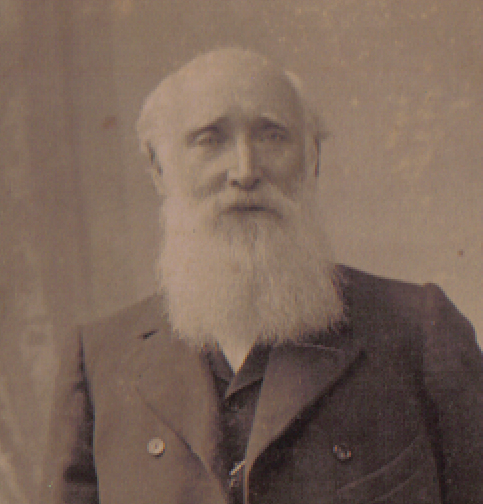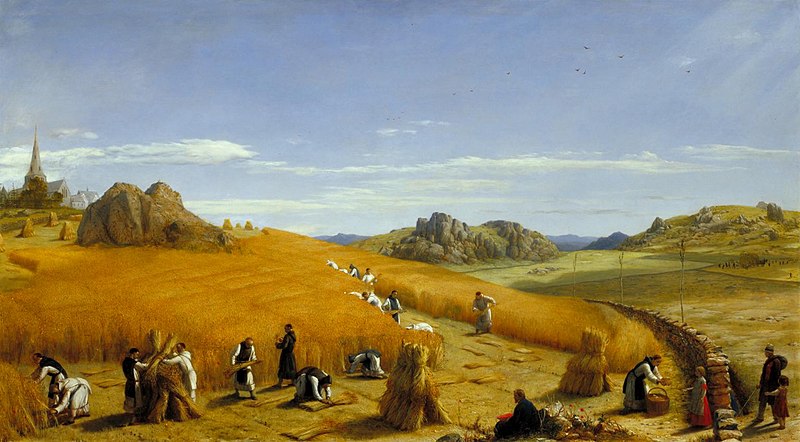John Rogers Herbert
Born January 23, 1810, at Maldon, Essex, England; died in London, March 17, 1890. He was admitted as a student of the Royal Academy in 1826, and in 1830 his first picture, “A Country Boy”, was exhibited at the Academy. For some years he painted pictures, chiefly inspired by Byron’s poems. He visited Italy in 1836, and sent several paintings to the Royal Academy, which attracted general attention. On his return to London, he made the acquaintance of Augustus Welby Pugin, the architect, whose portrait he painted. They became intimate friends, and through Pugin’s influence Herbert was received into the Church in 1840.
In 1841 he was elected an associate of the Royal Academy and exhibited a portrait of Cardinal Wiseman, whose close friend he remained until the cardinal’s death. From this time forward he chose for his subjects only religious scenes. The first of these was “The First Introduction of Christianity into Britain“, which at once established his reputation as a great historical painter. In the following year he exhibited “Sir Thomas More and his Daughter observing from the prison window the Monks being led to execution”, a work which attracted general attention. His diploma picture, upon his election as a Royal Academician in 1846, was “St. Gregory the Great teaching Roman boys to sing the Chant which received his name”. At that date there was a strong feeling among Protestants against the Church, and much indignation was expressed by the press against the subjects chosen and the religious tone of their composition. But Herbert was absolutely fearless and independent, for his works were recognized by connoisseurs as masterpieces. He was then selected by the Government to paint a series of nine frescoes in the peers’ robing room of the House of Lords, illustrative of human justice. The subjects chosen were: “The Fall of Man”; “His Condemnation to Labor”; “Moses bringing down the Tables of the Law“; “The Judgment of Solomon”; “The Visit of the Queen of Sheba”; “The Building of the Temple”; “The Judgment of Daniel”; “Daniel in the Lions’ Den”; “The Vision of Daniel”. All of these were executed in stereochrome, a process which had been adopted by Maclise, but which Herbert subsequently recognized to have been a mistake, as not being durable. He therefore painted replicas of them in oil. In 1849 he was commissioned to paint in the Poets’ Hall “King Lear disinheriting Cordelia”, a replica of which he exhibited in the Royal Academy in 1849. In 1860 he painted for Queen Victoria a picture of the Blessed Virgin which Her Majesty highly valued and preserved in her private apartments until her death. It is said that the last look of her husband, Prince Albert, on his deathbed was directed to this picture.
In the “History of the Royal Academy”, Mr. Sandby writes of Herbert: “All his pictures are the fruit of long study and most careful workmanship; he paints slowly and minutely; he is said to have cut out portions of his Lear picture five times before he was satisfied… Extreme simplicity, elaborate finish, deep and earnest expression, avoidance of accessories, except such as are suggestive of deeper meaning, and, in sacred subjects, a feeling of devotion and spirituality characterize his work, and a dignity in the human form rarely found in modern English artists. “From the time of his conversion Herbert proved himself a zealous and practical Catholic. He stood firmly by Cardinal Wiseman during the stormy period which followed the establishment of the Catholic hierarchy in England, and took a prominent part in all Catholic works. He was one of the founders of the English branch of the Society of St. Vincent de Paul, of the St. Vincent’s home for destitute boys, the patronage committee, etc. He was also one of the founders of the Peter’s Pence Association in England. With failing health, he retired in 1886, having built a handsome house and studio at Kilburn, in the suburbs of London and adjoining the church of the Oblates of Mary Immaculate. He died there and was buried in the Catholic cemetery at Kensal Green.
Archibald J. Dunn (Catholic Encyclopedia)












